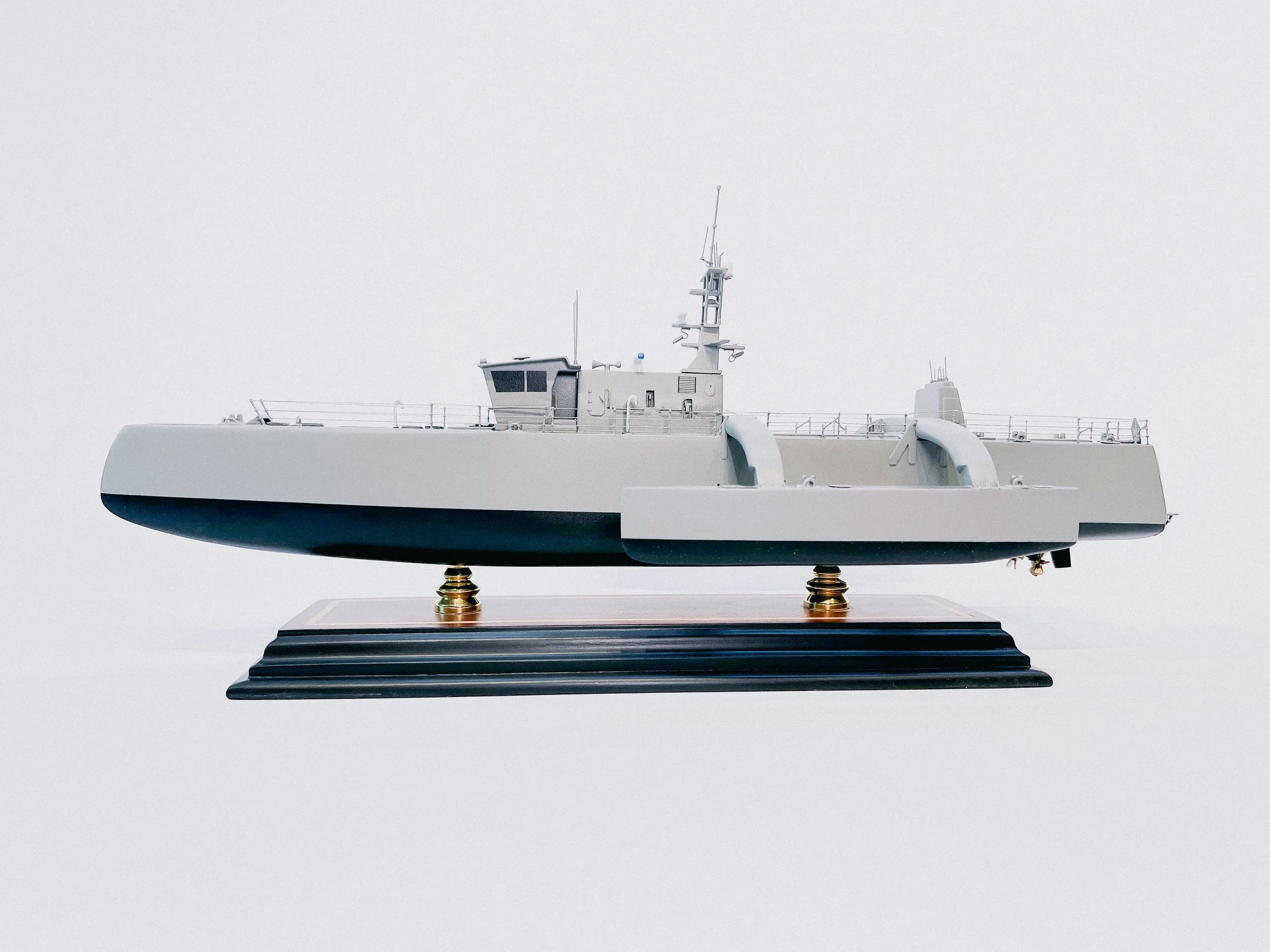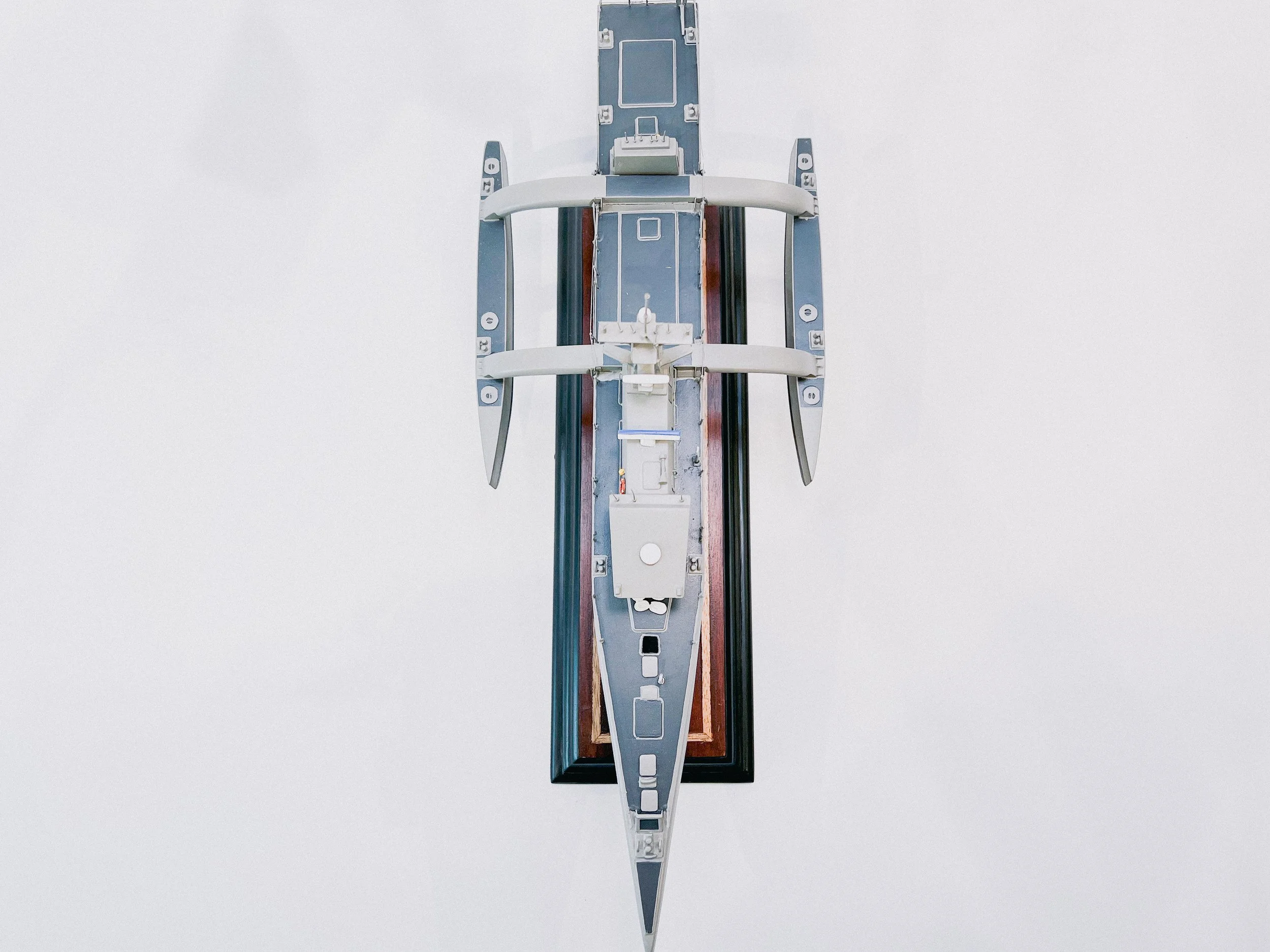zoom in on model
April 2016 – Present
Sea Hunter
Scale 1/100
Credit: Museum of Military Models, Clyde, Texas. Private Collection of Warren D. Harkins.ON VIEW
General Characteristics
Type: Unmanned surface vehicle
Displacement: 135 tons (standard) and 145 tons (full load)
Length: 132 ft (40 m)
Propulsion: 2x Diesel engines
Speed: 27 knots (50 km/h; 31 mph)
Range: 10,000 nautical miles (12,000 mi; 19,000 km)
Endurance: 30–90 days without supply
Complement: None
Armament: None
Description
Sea Hunter is an autonomous unmanned surface vehicle (USV) launched in 2016 as part of the DARPA Anti-Submarine Warfare Continuous Trail Unmanned Vessel (ACTUV) program. The ship was christened on 7 April 2016 in Portland, Oregon. It was built by Vigor Industrial. The vessel continues the line of experimental "Sea" ships, including Sea Shadow, Sea Fighter, Sea Jet, and Sea Slice. Sea Hunter is classified as a Class III USV and designated the Medium Displacement Unmanned Surface Vehicle (MDUSV).
A monitor transits the Mang Thit Canal, Mekong Delta, Republic of Vietnam, June 1968. Note the mortar amidships. National Archives K-52352 photographer PH1 Lynn, USN.Ownership & Province
-
Name: Sea Hunter
Builder: Vigor Industrial
Acquired: April 2016
Identification:
MMSI number: 369970970
Status: Sea trials
History & Related Content
SEA TRIALS AND OPERATIONS
On 22 June 2016, Sea Hunter completed initial performance trials, meeting or surpassing all performance objectives for speed, maneuverability, stability, seakeeping, acceleration/deceleration, fuel consumption, and mechanical systems reliability in the open ocean. Upcoming trials will include testing of sensors, the vessel's autonomy suite, compliance with maritime collision regulations, and proof-of-concept demonstrations for a variety of U.S. Navy missions. Sea Hunter was sent to the ONR in the summer of 2017 for operational testing and evaluation for mine countermeasure, EO/IR, and submarine detection capabilities. Plans for FY 2018 include adding intelligence, surveillance and reconnaissance (ISR), and offensive anti-submarine payloads.
In August 2022, Sea Hunter and other unmanned vessels USV Nimrod and USV Ranger (Ghost Fleet Overlord) participated in the Rim of the Pacific exercise (RIMPAC).
PORTLAND, Ore. (Apr. 7, 2016) Sea Hunter, an entirely new class of unmanned ocean-going vessel gets underway on the Willamette River following a christening ceremony in Portland, Ore. Part the of the Defense Advanced Research Projects Agency (DARPA)'s Anti-Submarine Warfare Continuous Trail Unmanned Vessel (ACTUV) program, in conjunction with the Office of Naval Research (ONR), is working to fully test the capabilities of the vessel and several innovative payloads, with the goal of transitioning the technology to Navy operational use once fully proven. U.S. Navy/John F. Williams - This image was released by the United States Navy with the ID 160407-N-PO203-598.DESCRIPTION
The initially unarmed prototype, built at a cost of $20 million, is a 132-foot (40-meter)-long trimaran (a central hull with two outriggers). It is an unmanned self-piloting craft with twin screws, powered by two diesel engines with a top speed of 27 knots (31 mph; 50 km/h). Her weight is 135 tons, including 40 tons of fuel, adequate for a 70-day cruise. Cruising range is "transoceanic," 10,000 nautical miles (12,000 mi; 19,000 km) at 12 knots (14 mph; 22 km/h) fully fueled with 14,000 U.S. gallons (53,000 L) of diesel, enough "to go from San Diego to Guam and back to Pearl Harbor on a tank of gas." Sea Hunter has a full load displacement of 145 tons and is intended to be operational through Sea State 5, waves up to 6.5 ft (2.0 m) high winds up to 21 knots (24 mph; 39 km/h), and is survivable through Sea State 7, seas up to 20 ft (6.1 m) high. The trimaran hull provides increased stability without requiring a weighted keel, giving her a higher capacity for linear trajectories and better operations in shallow waters, though the greater width decreases maneuverability.
A removable operator control station is installed during the testing period "for safety and backup" until it can be determined to reliably operate on its own. Operationally, computers will drive and control the ship, with a human always observing and taking charge if necessary in a concept called Sparse Supervisory Control, meaning a person is in control, but not "joy sticking" the vessel around. The system can patrol without human guidance, using optical guidance and radar to avoid hitting obstacles or other watercraft. The ship has a host of non-standard features because of her lack of crew, including an internal layout that offers enough room for maintenance to be performed but not for any people to be permanently present. It is fitted with quicKutter shaft protection rope/line cutters from Quickwater Marine in Perth. These devices protect the vessel from damage caused by rope or net caught by the propellers without affecting the vessel's performance.
The craft is expected to undergo two years of testing before being placed in service with the U.S. Navy. If tests are successful, future craft of this type may be armed and used for anti-submarine and counter-mine duties, operating at a cost of $15,000–20,000 per day, a fraction of the cost of a destroyer at $700,000 per day (in 2015, equivalent to $864,215 in 2022); it could operate with Littoral Combat Ships, becoming an extension of the LCS ASW module. Deputy U.S. Defense Secretary Robert Work said that if weapons are added to the ship, a human would always remotely make the decision to use lethal force.
Following successful initial development, it was reported on 1 February 2018 that DARPA had handed the development of Sea Hunter to the Office of Naval Research (ONR).
Visitors stand on the deck of the autonomous ship, ' Sea Hunter,' developed by DARPA, docked in Portland, Oregon, after its christening ceremony in early April, 2016. https://www.csmonitor.com/Technology/2016/0503/Check-out-Sea-Hunter-the-US-Navy-s-new-crewless-ship



































